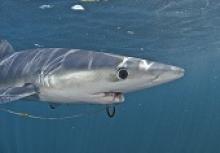New Article Published: Bycatch is Troublesome—Deal with It!

Shark with hook in mouth: 8. Sharks are usually unable to bite through wire leaders but have the potential to “self-release” from monofilament leaders under some circumstances. [Photo credit: Terry Goss Photography USA, Marine Photobank]
The word ‘bycatch’ has become a convenient and well-used term for all those ‘other’ species that get caught alongside the target tuna. But the problem is that term is inherently subjective and means different things to different people. Regardless of what it’s called, and whether it’s utilised or not, bycatch usually means trouble for fishers. Fundamentally, bycatch is bycatch because the goal was to catch something else. This means that from the outset fishers are less than pleased when catching bycatch and they may feel less inclined to record this catch with the required level of detail, simply due to lack of interest. As a result, fishers’ records of bycatch are often limited or non-existent, and observer programmes cannot always fill the gaps in data quantity or quality. Just as bycatch complicates life for fishers, it also complicates life for the fishery managers. Limited data lead to high uncertainty in the decisions about whether or how to protect bycatch populations from depletion. Bycatch management thus often takes a backseat to more pressing issues associated with managing target tuna species. A third problem with bycatch is that there is usually no quick fix. Mitigation technology may come at a price either in terms of gear cost, crew efficiency or reduced catch of target species, and just banning retention of bycatch will not necessarily prevent catch nor reduce mortality to sustainable levels for the most vulnerable species.
In tackling these issues for bycatch in tuna fisheries, the Areas Beyond National Jurisdiction (ABNJ or Common Oceans) Tuna Project has its work cut out for it. The Western and Central Pacific Fisheries Commission (WCPFC) has teamed up with the Secretariat of the Pacific Community (SPC) to implement three bycatch components of the Global Environment Facility (GEF)-funded, United Nations Food and Agriculture Organization (FAO)-led, ABNJ Tuna Project over a five-year period from 2014. The project’s challenge is to identify ways to make a small, focused investment pay a large dividend over the long-term.
To find out more about how the ABNJ (Common Oceans) Tuna Project is dealing with the thorny issues of bycatch read the full article Bycatch is troublesome - Deal with it (![]() 432.4 KB)
432.4 KB)

